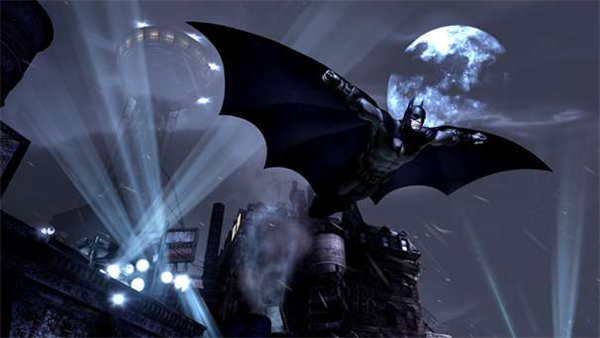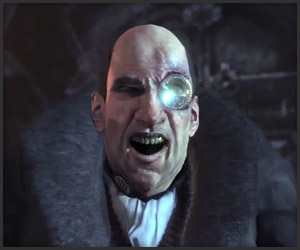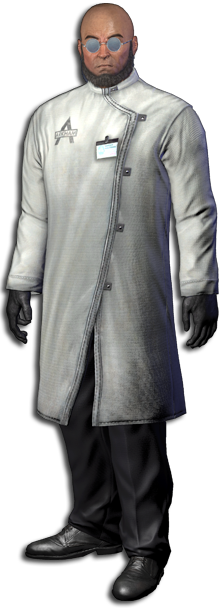A warning to start. As hopefully you may be able to infer from the title of this article, there follows a discussion of several major plot points in Batman: Arkham City, with particular emphasis on the final hour or so. As such, I am going to be dealing very heavily in SPOILERS. Feel free to go and play the game to its conclusion; this article will still be here when you get back. To prevent your eyes from being tempted to skim down page a few lines, I'll insert a large picture of the world's greatest detective here.

Okay, nobody here that shouldn't be? Great.
So now the warning's out of the way, I feel it must be said that I loved Batman Arkham City. In fact, still compelled to play side quests after finishing the main story, I still love Arkham City, and while I don't feel it will have the same lasting effect on me that Arkham Asylum did, on which more later, I thoroughly enjoyed the Caped Crusader's latest, and hold it as one of the very best games of this year.
What makes this surprising is that I'm not a huge Batman fan. Sure, if you asked me who my favourite superhero was, I'd probably squint at you slightly confusedly, look at my shoes and mumble 'um, Batman I s'pose'. This opinion, however comes largely from his recent gaming resurgence and Christopher Nolan helmed box office success. I know nothing about the world of comic books, and so to hear and read in reviews, podcasts and the like about how much fan service there is to Rocksteady's games and how every little detail of the comic's seventy two year history is lovingly paid homage to, may put the casual Bat fan such as myself off a little.
 Where Arkhams Asylum (totally) and City (to a point) succeed however, is by instilling such a strong sense of character that the non fan is drawn in. There's a very Zelda– esuqe feel to the Arkham games in terms of carefully themed level designs. Where Zelda's dungeons are designed to serve Link and his gadgets though, with carefully designed puzzles aiming to teach you how to use your most recently obtained toy, Batman's levels are love letters to their bosses. Through their jibes over radio to their respective henchmen and incidental detail, you learn so much about each supervillain that unlockable character profiles are rendered largely redundant, and so when finally confronting each boss, the satisfaction in prevailing is immense.
Where Arkhams Asylum (totally) and City (to a point) succeed however, is by instilling such a strong sense of character that the non fan is drawn in. There's a very Zelda– esuqe feel to the Arkham games in terms of carefully themed level designs. Where Zelda's dungeons are designed to serve Link and his gadgets though, with carefully designed puzzles aiming to teach you how to use your most recently obtained toy, Batman's levels are love letters to their bosses. Through their jibes over radio to their respective henchmen and incidental detail, you learn so much about each supervillain that unlockable character profiles are rendered largely redundant, and so when finally confronting each boss, the satisfaction in prevailing is immense.
The best example of this in Arkham City is the Penguin, a character I had very little knowledge of in my graphic novel/ Tim Burton movie ignorance, but who gets over with the player in a very meaningful way, being not only one of the first major characters you encounter out the gate, but in having his museum section lovingly designed around him, complete with bragging one liners in artifact descriptions. When you finally get your hands on him, after he hides behind scores of goons in typical cowardly heel fashion, it's hard not to let out a whoop of satisfaction.
And on advances Arkham City's seeming slow burn of a story. Forgetting sidequests and their host of DC cameos for a second, there's just so much going on here. Joker is disease ridden and slips Wayne some of his blood so he's infected, too. Mr. Freeze is an uneasy ally, first relying on Batman for aid, then turning on him, then begging him once more to help find his wife. Ra's al Gul tempts our hero with immortality, provided the Batman can break his moral code and take a life. Above all of this however, sits Hugo Strange.
 As the character that manages to put Bruce Wayne into Arkham City in the first place, as one of few to know he and the eponymous superhero are one and the same, and as the character who sits as the polar opposite to the Bat's moral values, laying waste to most of the city's denizens at the end of the game's second act, Strange seems to have Batman's number, and sets himself up for a mighty fall toward the game's conclusion.
As the character that manages to put Bruce Wayne into Arkham City in the first place, as one of few to know he and the eponymous superhero are one and the same, and as the character who sits as the polar opposite to the Bat's moral values, laying waste to most of the city's denizens at the end of the game's second act, Strange seems to have Batman's number, and sets himself up for a mighty fall toward the game's conclusion.
Here though is where things seem to break down. Going after Strange to stop his evil plan is a ten plus hour journey, but what should be a satisfying encounter is a non event. Strange hides behind six or so shotgun toting guards that are dispatched in one of the game's easier stealth sections. Them disposed off, it would be reasonable to assume a huge dust up would ensue, but instead Strange is tackled in a cutscene. Perhaps he isn't much of a fighter, but surely a mad psychiatrist would have the potential to play some psychotropic enhanced Scarecrow esque head games with Batman a la Arkham Asylum?
Tucked away in the same deflating cinematic is Ra's al Gul, a boss you defeated several hours prior in what was a much more satisfying encounter, showing up and essentially saying 'Hi, remember me? Yep, I was the main bad guy all along. Never saw that coming, did you?' No, no I didn't. Did I have to see it all? Still, not to worry, as the immortal baddie is written off in the same explosion that kills of Strange entirely.
It's a baffling sequence for sure, but this is not the main event. From here, you have to rescue Ra's' daughter from the clutches of the Joker, who seems to take over the lead villain role as the game progresses. Joker is, no doubt, an extremely compelling figure, but it seems like a bait and switch to build Hugo Strange so well as a rarely seen evil mastermind, and then deliver Joker as your main antagonist. It's here as well that the disease both the B-man and Mister J carry, and the cure thereof, takes precedence over breaking out of Arkham City as the main objective driving the player. This is all very well and fine, but the game makes disappointingly little attempt to drive the point home that you and Joker are nearing death. Prior to battling Ra's, Batman stumbles, collapses and has near death experiences, which are powerful events that bring to mind the amazing fourth wall shattering Scarecrow fights in Asylum. Here's where the two games differ in approach, however. Asylum came back and revisited the Scarecrow angle several times over the course of the game,weaving the storyline in with other events to depict Batman as a figure on the precipice of a nervous breakdown. In City, characters will comment on how haggard you look, or how near you are to dropping down dead where in reality you're mostly as spry as at any other point in the game, cheerily leaping around and completing sidequests while that cure you need so desperately can wait.
Rocksteady seem more eager in City to protect the Batman character and keep him looking strong than in Asylum. Rather than heading to face Joker swooping between rooftops and deftly taking out rooftop snipers with some smooth Jiu Jitsu, I'd have loved to have played Batman staggering through alleyways, struggling to take a breath behind a bin where previously he'd bravely defended a wrongfully imprisoned innocent from knife wielding thugs.
Once you reach the cinema to go toe to toe with the Joker, the game faces itself with a quandary. How to give the player a final boss fight when Batman could easily overpower a weakened Joker from a storyline perspective? Hide him behind more goons? No, they did this before. Power Joker up with Titan? Most gamers without the patience of Job hated this last game round. Instead, we see the 'ol' fake Joker routine'. As your final fight is not with Joker himself but… Clayface. Now, as I've said before, I am not familiar with comic books, but I have no idea who Clayface is, and faced with confronting him, felt cheated out of the story's payoff in a major way. Whereas Rocksteady are usually so careful in telegraphing a boss' presence through hints in the environment, or nods earlier in the gamedesigned to familiarize yourself with your nemesis, Clayface drops in and is taken out in the blink of an eye.
From there the game's ending is left to cutscene work, where Joker, the cure to what ails him spilled on the ground, dies. Again, and I feel I can't express this enough, I am coming at this from the perspective of a non comic fan, but I would think that the death of such a prominent figure (coupled with Mark Hamill's retirement from voicing the role in any medium), not to mention the righteous crusader causing (albeit indirectly) his demise, should be a huge deal. Instead, with so much happening toward the end of the game, this feels nothing like the watershed moment for Batman that it should be. As your hero walks out of the Arkham City gates Commissioner Gordon asks 'what the hell happened in there?'. I had similar sentiments.

Maybe Arkham City's two year development cycle was too much of a tight limit, but it feels to me- with a story so desperate to hurtle toward its conclusion- that there is an awful lot on Arkham City's cutting room floor. An extra couple of hours could have made everything here mean so much more, but instead it remains an amazing game with a flat and lifeless final act.
Randy Smith of iOS developer Tiger Style wrote in his Edge magazine column recently about the relative merits of 'push' and 'pull' storytelling; of the traditional means of telling story through dialogue and cinematic interludes versus using clues in the environment to let the player figure out the plot by themselves. He talks about how videogames often struggle with convincing dialogue, but pushing story also leads to issues with writing a convincing ending that a 'pull' story game player would just draw his own conclusions from. There are great stories told in games with conclusions to match, but for every pop corn movie satisfying fist pump like Uncharted, or heart wrenching final Shadow of the Colossus or Sword and Sworcery scene, there are several hole ridden Heavy Rain messes, inane swathes of Metal Gear Solid 4 exposition , or, as in Arkham City, an end that just doesn't meet the expectations generated by its earlier hours.
VentureBeat's mission is to be a digital town square for technical decision-makers to gain knowledge about transformative enterprise technology and transact. Learn More
